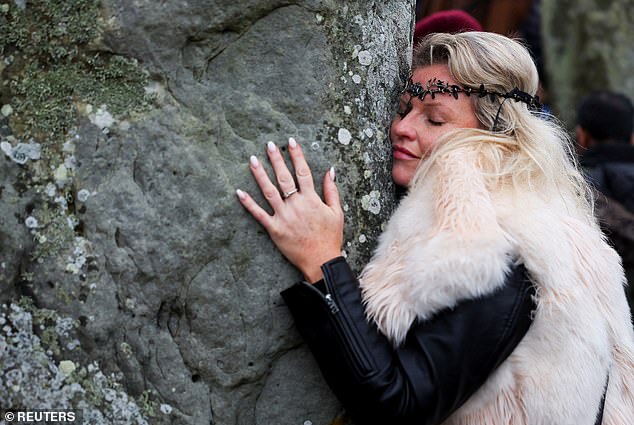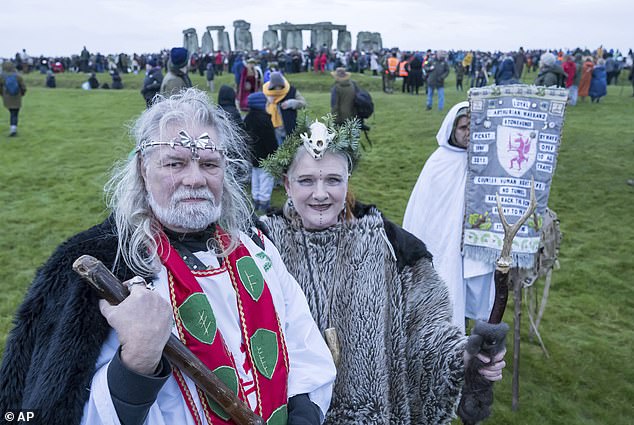Thousands of tourists, pagans, druids and people who simply long for the promise of spring marked the dawn of the shortest day of the year at the ancient monument of Stonehenge on Saturday.
Revelers cheered and beat drums as the sun rose at 8:09 a.m. over the giant stones on the winter solstice, the shortest day and longest night in the northern hemisphere.
No one could see the sun through the low winter clouds, but that didn’t stop a flurry of drumming, chanting, and chanting as dawn broke.
Chris Smith, 31, who had come to Stonehenge for the first time for the winter solstice, said he was there because of the “spiritual attraction of the area”.
He said: “It is about renewal, rebirth, we are entering the new year and it is also a good time to recognize what is happening in the year that has passed.”
“For me, I’ve been through a bit of a tumultuous year, a lot has happened for me in the last 24 months, and this is an opportunity to consolidate everything that has happened this year and bury it in the past and be able to move forward to the next New Year.’
The official added: ‘There is such a vibe. I mean, if you look around, you have everyone here, there is so much energy in the space.
“You can really feel that everything is good vibes. People here are just having fun and that is one of the attractions of these types of events.
Thousands of tourists, pagans and druids marked the dawn of the shortest day of the year at the ancient Stonehenge monument on Saturday.

A reveler attends the winter solstice celebrations at the stone circle at Stonehenge today.

People take part in winter solstice celebrations during sunrise at the prehistoric monument Stonehenge on Salisbury Plain in Wiltshire.
There will be less than eight hours of daylight in England on Saturday, but then the days will lengthen until the summer solstice in June.
The Sun’s apparent position in the sky changes throughout the year.
This occurs because the Earth orbits at an angle of 23.4 degrees on its axis.
During summer in the Northern Hemisphere, the North Pole is tilted toward the Sun, so it receives more direct sunlight and more hours of daylight.
Meanwhile, during winter in the Northern Hemisphere, the North Pole is tilted away from the Sun, resulting in fewer hours of daylight.
The solstices occur twice a year and are known as the “summer solstice” and the “winter solstice.”
“The summer solstice, which occurs around June 21 in the Northern Hemisphere, is the day of the year with the longest daylight period, while the winter solstice, around December 21 in the Northern Hemisphere, is the day with the shortest period of daylight,” the Meteorological Office explained.
According to the astronomical definition, today is the beginning of winter.

Solstices occur twice a year and are known as ‘summer solstice’ and ‘winter solstice’.

Arthur Pendragon poses for a portrait while taking part in the winter solstice celebrations at Stonehenge.

A ribbon-adorned horse performs today during the winter solstice celebrations at Stonehenge.
“The astronomical calendar determines the seasons due to the 23.5 degree inclination of the Earth’s axis of rotation with respect to its orbit around the Sun,” explained the Meteorological Office.
However, many meteorologists, including the Met Office, typically use a meteorological definition of the seasons.
Meteorological seasons consist of dividing the seasons into four periods, made up of three months each.
So by this definition, the first day of winter is always December 1st and ends on February 28th (or 29th during a leap year).
The winter solstice is celebrated by cultures around the world. In the United Kingdom, Stonehenge is a winter and solstice celebration site.
People visit Stonehenge to catch a glimpse of the sun as it shines through the stones, including neodruids and neopagans.

A person’s face is painted with blue paint as they take part in winter solstice celebrations at Stonehenge, England, on Saturday.

The winter solstice is celebrated by cultures around the world. In the United Kingdom, Stonehenge is a winter and solstice celebration site.

A man places his hands on one of the stones during the winter solstice celebrations at Stonehenge today.

For ancient cultures, the passage of time was important, particularly for the people who lived around Stonehenge and were farmers who grew crops.
The ancient structure was built to frame the sun during midwinter dawn and the summer solstice, indicating when the days will begin to lengthen or shorten.
For ancient cultures, the passage of time was important, particularly for the people who lived around Stonehenge and were farmers who grew crops.
In winter, the sun sets southwest of the stone circle.
The solstices are the only times when visitors can get directly up close to the stones at Stonehenge, and thousands of people are willing to get up before dawn to soak up the atmosphere.
The stone circle, whose giant pillars required 1,000 people to move each, was erected about 5,000 years ago by a sun-worshipping Neolithic culture.
Its purpose is still debated: was it a temple, a solar calculator, a cemetery, or some combination of the three?

Morris dancers participate in winter solstice celebrations.

People touch one of the stones as they take part in winter solstice celebrations during sunrise at the Stonehenge prehistoric monument.

A reveler interacts with a stone as people gather to celebrate the pagan ‘Winter Solstice’ festival at Stonehenge.

The solstices are the only times when visitors can get directly up close to the stones at Stonehenge, and thousands are willing to get up before dawn to soak up the atmosphere.
In a paper published in the journal Archeology International, researchers from University College London and Aberystwyth University said the site on Salisbury Plain, about 80 miles southwest of London, may have had political and spiritual significance.
This follows the recent discovery that one of the stones at Stonehenge, the only stone that lies flat in the center of the monument, nicknamed the “altar stone”, originated in Scotland, hundreds of kilometers north of the site.
Some of the other stones were brought from the Preseli Hills in southwest Wales, nearly 240,150 miles to the west.
Lead author Mike Parker Pearson, of the UCL Institute of Archaeology, said the geographical diversity suggests Stonehenge may have served as a “unifying monument for the peoples of Britain, celebrating their eternal links with their ancestors and the cosmos.”


